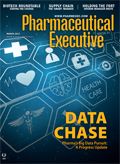Big Data: Is It Crunch Time for Pharma?
With big data one of the hot healthcare topics of the moment, we gauge pharma’s response to the hype to see if the industry is poised to take advantage of the promise of advanced analytics.
With big data and advanced analytics progressing from fad to frontier status, Pharm Exec examines the readiness of the biopharma industry to take advantage of this promise. Can new digital health tools be harnessed to help advance new treatment approaches and aid decision-making?
“The emergence of big data,” wrote Ryan Copping and Michael Li in The Harvard Business Review (November 29, 2016), “is providing pharmaceutical companies with an opportunity to gain novel insights that can enhance and accelerate drug development.” From their vantage point, the authors explain that they “have seen how the pharmaceutical industry has leveraged big data for some potentially revolutionary advances and the challenges it has faced along the way.”
Copping is a data scientist and global head of real-world data science analytics at Genentech; he and Li point to the company’s advances in the area in the last two years, building a big-data infrastructure (“a platform that can analyze billions of patient records in seconds”) and “aggressively recruiting and developing people with the requisite skills.” But the authors concede that “it will not be easy to learn how to tap the full potential of real-world data.” The tremendous opportunities generated by these advances are tempered by considerable resourcing and capability development challenges.
Indeed, not many pharma companies, certainly in the small or mid-size range, can boast of matching Genentech’s progress in the big data field. Those that can include Berg Analytics, which began investing efforts into the idea of data-driven research as long ago as 2007. Berg co-founder and chief analytics officer, Slava Akmaev, told Pharm Exec that the company now has “a well-developed platform that we have used to populate our internal pipeline of therapeutic targets and diagnostics and guide the development of some of our flagship products.” One of those is a cancer drug already in Phase II trials.
But while Akmaev has observed “a lot of resolve in the last two years on the big pharma side to invest in big data analytics,” he says it’s difficult to gauge how quickly companies just starting in the space will be able to show that their artificial intelligence (AI) or big data platforms can deliver products to the market.
Big data barriers
For Steve Labkoff, executive director, medical affairs strategy, at Purdue Pharma and a fellow of the American College of Medical Informatics, a key barrier preventing pharma from launching successfully into big data optimization is its workforce. “There really aren’t enough well-trained people who understand how to deal with big data problems,” he told Pharm Exec. “Organizations that are not that well informed think that big data is simply an IT problem and if you throw enough servers at it you are
Steve Labkoff

going to be able to solve your problem or get better insights. But that is about as naïve a perspective as you can get. It’s like going out and buying a high-performance car and getting your local mechanic to take care of it.”
Labkoff believes organizations need to take a three-pronged approach to glean the true value of big data. “First, you definitely need IT people,” he says. “But, secondly, you need data scientists, or informaticians, who are a different breed and who understand the nature of where the data comes from and what it actually means at a granular level. For example, healthcare data needs to be put into a clinical context; if not, people start drawing conclusions that may be erroneous.”
The third leg includes the business leaders “who themselves have to have some degree of insight in terms of asking the right questions about the data,” says Labkoff. There are companies executing this approach. At Pfizer, Labkoff helped to establish “what was at the time probably the first healthcare informatics department in any pharma, back in 2003.” But, he adds, “Pfizer, for example, is a resource-rich company; it has the luxury of being able to build what it needs or to buy it in the market place. Other companies don’t have that luxury; they have to be far more selective, and they’re competing for a rare commodity.”
Akmaev believes that the data scientist shortage has improved compared to five years ago. "The pool of candidates is growing," he says. “We see a lot of people with a quantitative background and experience leaving the genomics and next-generation sequencing organizations and opting to work more on the AI side of things, analyzing multi-omic data, for example.”â¨
The wider problem, says Akmaev, is rooted in industry culture. “Looking at it from my background in mathematics, I feel that pharma is one of the least quantitative industries,” he says. “Adoption of advanced analytical tools, mathematical modeling and AI-based approaches to analyzing data has been slow compared with other industries such as finance and IT.” Akmaev notes that many leaders and
Slava Akmaev

decision-makers in the pharma space have backgrounds in the “non-quantitative sciences, such as biology, biochemistry, and medicine.” Compounding that is an ongoing skepticism of systems biology tools.
“Pharma is still suffering from the hangover of the early 2000s, when we had the promise of the human genome,” says Akmaev. “There was a hype at that time that by using bioinformatics and mathematical methods, we can solve human disease problems, and it fell short of that.”
If this “cultural barrier” requires wholesale change management, it is not just in pharma, but across the healthcare spectrum, says Dharmendra Sahay, managing principal at ZS. Trusting combined data that is generated from various sources “is going to require a mindset change not just on the part of pharma but physicians and patients as well.” According to Sahay, getting to a position of trusting the data lies in leveraging its partners to ensure the right platforms are in place to analyze unstructured data. This would ensure its provenance, accuracy and usability.
Similarly, Joel Selanikio, MD, CEO and co-founder of Magpi, believes that technology holds the key. He told Pharm Exec: “I’m not worried about a shortage of data scientists, as I think in the short-term the market is addressing that. What’s more interesting to me are the techniques that are being created, using AI and other technologies, to be able to put vast quantities of data to use-and which may render ‘data scientists’ obsolete.”
A wearable feast
As pharma considers its big data workforce options, the wearable devices space is pushing ahead regardless. With the consumer space rapidly expanding with data from wearables, Selanikio contends that “over time, more and more health data will be coming from outside the healthcare industry.” A 2016 research paper by Validic reported that the next five years will see pharma and biotech firms turn in much larger numbers to digital health tools, including wearables, “to better collect, analyze and act on patient-generated health data.” The survey revealed that over 60% of 200 biopharma respondents said they have used digital health technologies in clinical trials, and over 97% plan to use these tools increasingly.
A closer consideration of the pharma perspective, however, shows a more measured approach to patient-generated health data. Labkoff says: “I think wearables right now are where PDA (personal digital assistant) computers were in the mid-1990s, when the Apple Newton and PalmPilot came out. There was all this promise of what they could do, but they were basically 10 years too early; even Apple failed at this time. The jury’s still out on wearables; I would advise taking a watch-and-wait approach. You may be able to measure something 6,500 times a day, but that doesn’t mean that the information is going to be meaningful or useful.”
Akmaev agrees. “We need to make sure that this change in the industry is not overhyped and that it delivers three to five years down the road,” he says. “By that I mean we have tools and applications that can actually drive real clinical decision-making.”
While there is broad consensus that wearable devices become more ubiquitous in particular therapy areas, Steve Rosenberg, Oracle’s senior vice president and general manager of its Health Sciences Global Business Unit, says, “I don’t think we’re going to see the Wild West of wearables.”
Oracle is working with a handful of pharma companies that have experimented with various devices and are now trying to figure out their practical application in clinical trials. “Our role in this ecosystem,” says Rosenberg, “is not to decide what wearables should be used or what studies a certain device should be used in, but to provide the technology and the tools
Steve Rosenberg

so our customers can make those choices and not have technology be the barrier to making those choices.”
The challenge for pharma is not so much the data from wearables but “when do we use the device to collect the data from a wearable standpoint,” he says. Devices generate an enormous amount of data but the data must be fit for purpose.
“You’ll see wearables being used where it makes sense to collect the data on a wearable, but pharma has to be more cognizant of convenience to the patient,” says Rosenberg. “Every time we put a wearable into a clinical trial, for example, we have to educate the site on how to train the patient to use it.”
The wearables phenomenon takes things back to the trust issue, and concerns about patient privacy have long been looming obstacles on the road to big data promise. “A lot of patient data is currently not identified and the patients have to allow its usage,” says Sahay. “They may allow the provider to use it, but may be suspicious of pharma using it.”
Akmaev suggests the industry is perhaps getting stuck on this point. He explains: “Of course we need to maintain confidentiality and make sure none of the personal patient information is misused. But if you take it in perspective, I don’t know if the conversation about privacy in healthcare is much different than in other industries.”
For Labkoff, “The privacy issue shouldn’t be an obstacle; it’s just one facet of the problem to be solved. Big data doesn’t generally care about individuals’ data; most big data projects are looking at aggregate information to make a decision around a population, whether that is a population of doctors or patients or drug candidates.”
Where the privacy issue does come into play, according to Rosenberg, is in genomics. “You may have a full genome sequence from a patient; that is personal, identifiable information. But while it might be individual, it’s not necessarily identifiable,” he says. “But there is hesitation in the academic research centers to share that data with others. Still, I think that when we get to the point when all that data is becoming mainstream, the privacy issues will be resolved.”
Inflated expectations?
If we see big data as residing on Gartner’s Hype Cycle somewhere near the “peak of inflated expectations,” then the next, inevitable move is downward into the “trough of disillusionment,” before recovering to a “plateau of productivity.” This may not be a negative thing; it could allow some pharma companies to take the “watch-and-wait” approach Labkoff advises with wearables before hurrying into costly big data projects that may ultimately have little value.
If big data is currently overhyped, there is consensus that it will deliver results in the long run. “I think it takes hype to get enough movement, to get pragmatism into the process,” says Rosenberg. “There’s not as much data as there is, for example, in banking applications. We are not talking about an unmanageable amount of data; it’s just a question of what it’s going to be used for. There’ll be pockets of success along the way. Two to three years from now you’ll see a pretty large proliferation of data, but until then the success will remain in certain therapeutics areas.”
Labkoff agrees that “we’re in the midst of a classic hype curve, definitely.” But, he adds, “there are very focused-use cases for big data, and it is making a big difference in certain places, such as genomics, patient recruitment, and virtual clinical trials. I don’t think it is going to suffer the slings and arrows of other ‘fads.’”
The futurist Roy Amara once famously said that technology’s impact is overstated in the short term but understated in the long term. “You found that in the dot.com boom, and there is a bit of that with big data,” says Sahay. “If pharma and healthcare are going to expect big data results equivalent to what, say, Amazon or Uber are seeing, then they are going to be disappointed. But as the barriers are addressed in the medium to long term, the impact will be transformational.”
Julian Upton is Pharm Exec’s Online and European Editor. He can be reached at julian.upton@ubm.com

Is Artificial Intelligence a ‘Product’? Products Liability Implications for AI-Based Products
April 10th 2025As the physical products we use evolve to become increasingly complex, traditional products liability frameworks may not always fit to provide remedies for harm that can result from using novel product types.